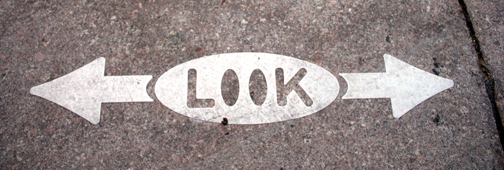On Jan. 20, representatives from the city’s Department of Transportation delivered their report on last year’s reconfiguration of Prospect Park West to a very interested audience at the Old First Reformed Church. Their message was a simple one: It works.
 The data presented at Community Board 6’s Transportation Committee meeting showed that the traffic-calming project has resulted in more cars obeying the speed limit, fewer accidents, and no change in travel times or traffic volumes on the thoroughfare. The new two-way bike path has led to more adults and children riding safely on the lane and far fewer on the sidewalk.
The data presented at Community Board 6’s Transportation Committee meeting showed that the traffic-calming project has resulted in more cars obeying the speed limit, fewer accidents, and no change in travel times or traffic volumes on the thoroughfare. The new two-way bike path has led to more adults and children riding safely on the lane and far fewer on the sidewalk.
Even with these results, the DOT representatives — Assistant Commissioner Ryan Russo and Director of Bicycle Programs Josh Benson — recommended some ideas to make the reconfiguration even safer for all users.
Russo and Benson’s study on vehicular traffic compared data taken along the roadway from July to September 2010, the six-month period after the three-lane drive became two lanes, with similar periods in 2007-09. The results showed:
- Only 20% of speeders drove above the speed limit after the reconfiguration, much better than the 74% before.
- Average speed dropped from 34 to 26 miles per hour.
- Car crashes were down 16%, and crashes that caused injuries were down 63%. “We did have six crashes in July 2010 as people were getting used to the new configuration,” Russo said. There were 25 total crashes in the study period versus 30 on average in each previous year. “We expect those numbers to get better over time.”
- Of five people injured in crashes in the 2010 period, none was a pedestrian; prior years had about two injuries per month to pedestrians.
- Traffic volume on Prospect Park West did not change significantly, which meant the new setup did not have any impact on parallel roadways like Seventh Avenue.
- Travel times did not change much, either. “It took about three minutes to drive down Prospect Park West [before the change] and about three minutes after,” Russo reported. There was also no change in travel times for emergency responders.
Perhaps the greatest success was among people of all ages using the bike lane. According to DOT data, weekday cycling has tripled and weekend cycling has doubled. Cyclists using the sidewalk during the week dropped from 46% to 3%, and on weekends from 20% to 4%, meaning greater safety for both riders and walkers. Fewer children were riding on the sidewalks, too.
“We’ve never seen so much rapid acceptance on one of our bike-lane projects,” Russo said.
Another important measure of project success for the DOT is mobility: how many people are moving through a given corridor. With the reconfiguration, Prospect Park West now handles 13% more people in the morning rush and 9% more in the evening, thanks to more cyclists. In fact, bicycle traffic now makes up 12% of evening rush-hour traffic.
“Speeding has been reduced substantially without any negative effect on vehicle throughput,” said Eric McClure, Civic Council treasurer and co-founder of Park Slope Neighbors, who attended the meeting. “Accidents, and even more importantly injuries, are down. Cyclists have gravitated to the bike path, and without a doubt, it’s the city’s most popular on-street bike facility for kids. And the tweaks that DOT has recommended will make it even better.”
Those “tweaks,” like the entire project, came about from requests and input from community organizations, elected officials, and residents. One suggested change is to add low, thermoplastic rumble strips before intersections along the bike lane to remind riders to watch for pedestrians. Another idea is to raise and landscape the beige pedestrian islands in crosswalks to deter parking in those spots.
In addition, the report suggested narrowing the rather wide buffer between parked cars and cyclists from Union Street to Montgomery Place. “This would make it consistent with the buffer south of Montgomery,” said Russo, “and allow for better entry to Prospect Park West from Grand Army Plaza.”
Some attendees disputed the agency’s figures on bicycle traffic. Park Slope resident Lois Carswell talked about other bicycle counts that show fewer riders on Prospect Park West — up to 50% less on weekdays — than DOT’s. She cited a Freedom of Information Law request for the agency’s raw data, filed by the group Neighbors for a Better Bike Lane (NBBL) and other residents. “It makes the community skeptical,” she said.
The discrepancy, Russo noted, was due to where those counts were made and how cyclists use the bike lane on different days. NBBL’s observations were made at Grand Army Plaza, while DOT’s were between Third and Fifth Streets. On weekdays, for example, commuting riders “are connecting with the Second and Third Street bike lanes that go down the Slope to the bridges and to Manhattan.” Fewer would head toward Grand Army Plaza, where the same connections are not available.
Another audience member questioned whether the project was “worthwhile to pursue in light of our city’s budget problems.” The entire project, according to Russo, cost about $300,000, 80% of which was paid for by the federal government under a program for new bicycle programs. Removing the lanes would cost at least three times more, with no federal reimbursement.
Overall, the crowd of about 200 showed their approval of the redesigned Prospect Park West, citing how much safer it is to cross and to bike, especially with children. “More parents are comfortable in having children in this lane than others,” said Community Board 6 member Dave ”Paco” Abraham, which is a “great indicator of safety and success.”
The data, said Councilmember Brad Lander, “shows the project is working and we should keep it and move it forward.”
The full evaluation from the Department of Transportation can be downloaded here.
from the January 2011 Civic News

